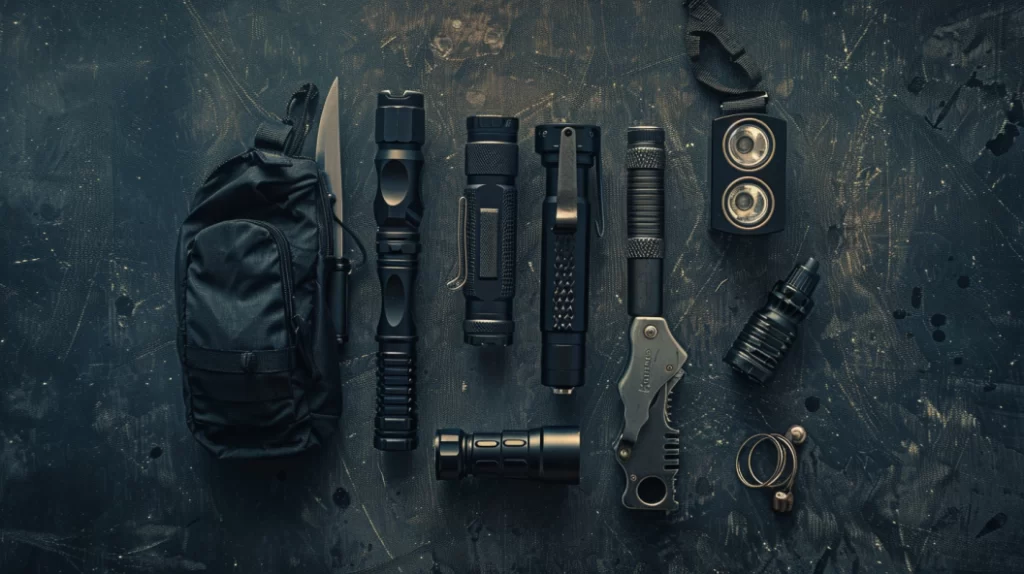Be Prepared, Be Protected: Choose the Right Self-Defense for Your Everyday Carry

When selecting self-defense tools for your everyday carry, it’s essential to consider a few key factors. First, ensure the tools comply with local laws to avoid legal issues. Focus on choosing comfortable and easy-to-use tools, as you want something you can rely on in a stressful situation. Look for discreet options that blend with your daily routine, like keychain weapons or compact stun guns. It’s also crucial to understand how effective each tool is, whether it’s pepper spray or an electric taser, and to practice using them regularly to be prepared. By exploring these aspects further, you can enhance your safety strategy and be better equipped to protect yourself.
Key Takeaways
- Assess legal implications and ensure chosen tools comply with local laws and regulations.
- Evaluate personal comfort with the tool, considering ease of use and ergonomics.
- Choose discreet, compact options that can be easily carried and concealed daily.
- Understand the effectiveness of each tool, from pepper spray to electric tasers.
- Engage in regular training to develop quick access and practical deployment skills.
Assessing Legal Implications
Before you pick a self-defense tool, understand the local laws and regulations governing its use. This is crucial to staying on the right side of the law and avoiding legal trouble. Regarding personal defense, being part of a community means following its rules. Knowing the laws and regulations related to self-defense helps you feel safer and ensures that your actions are legally acceptable.
In self-defense laws, it’s crucial to remember the principle of proportionality. This means the force you use to defend yourself should match your threat level. It’s essential to choose the right self-defense weapons accordingly. Using lethal tools in situations where non-lethal force would suffice can have serious legal consequences.
To navigate these legal considerations effectively, individuals should consult legal resources or experts who can provide detailed insights into the legal boundaries specific to their area. This proactive approach helps them choose the right self-defense tools that offer protection and comply with local regulations. Being well-versed in these parameters allows individuals to confidently and legally protect themselves, reinforcing their belonging to a lawfully conscious community.
Evaluating Personal Comfort
When you pick self-defense tools, it’s vital to consider your comfort and confidence in using them. This ensures they can be deployed effectively when facing danger. Your comfort impacts your ability to react quickly and decisively in stressful situations. Ensuring a tool feels good in your hands and matches your physical skills can significantly improve your readiness and effectiveness.
Here are vital considerations to help you evaluate your comfort with self-defense tools:
- Ease of Use: Choose tools you can operate comfortably and intuitively to avoid fumbling during critical moments.
- Ergonomics: Select tools that fit well in your hand and whose design complements your physical strength and stature.
- Handling: Practice with the tool to maintain and control a secure grip under pressure.
- Comfort Level: Consider how carrying a tool impacts your daily comfort, both physically and psychologically.
- Decision-Making: Reflect on your confidence with the tool in various scenarios to better prepare for actual use.
Exploring Discreet Options
Discreet self-defense tools are a great option if you want to boost your safety without attracting notice. They’re compact, easy to carry, and provide a sense of security without being obvious. People who value discreet protection find everyday carry (EDC) options useful daily.
Keychain and compact stun guns blend seamlessly with everyday items and offer ready defense mechanisms. These portable self-defense options fit easily into your daily routine and ensure you are always prepared without drawing unnecessary attention.
Below is a table outlining some discreet self-defense tools suitable for everyday carry:
| Tool Type | Characteristics |
| Compact Stun Guns | Small enough to fit in a pocket, offers immediate defense capability |
| Keychain Weapons | Easily attachable to keys, quick to deploy |
| Electric Tasers | Concealable, immobilizes target effectively |
| Portable Alarms | Emits loud sounds to deter attackers and alert others |
When you include self-defense tools in your everyday carry, you become part of a community of proactive and prepared individuals. These tools help you feel connected to a group that values safety and being ready for any situation. So, by having these items with you, you are embracing a lifestyle that prioritizes being safe and always prepared.
Understanding Weapon Effectiveness
It is important to know which self-defense tools are most effective for staying safe. When deciding which tools to carry, consider how well they can protect you in different situations.
Each self-defense weapon has specific features to tackle everyday threats, ensuring you feel a sense of belonging and safety in your community.
- Pepper Spray: Known to incapacitate an attacker by causing temporary blindness and respiratory distress, it works best at close range, offering immediate personal protection.
- Stun Guns: These devices deliver high-voltage shocks that disrupt muscle control, temporarily immobilizing an assailant without causing permanent harm.
- Palm Weapons: Small and easily concealed, palm weapons can cause pain and deter an attacker, designed to extend your defensive capabilities subtly.
- Personal Alarms: These alarms emit a loud sound to attract attention and deter potential attackers, serving as a nonviolent method of personal safety.
- Effectiveness Considerations: Understanding each tool’s capacity to incapacitate an attacker and how it aligns with your needs is pivotal for adequate personal protection.
Choosing the right self-defense tools can help you feel secure and prepared, enhancing your ability to navigate your environment confidently.
Training and Skill Development
Learning how to use self-defense tools effectively is important. It helps you remember how to use them correctly during stressful situations. Training makes it easier for you to grab and use your chosen tool without overthinking. Skill development sessions also help you learn the limits and how to use tools like pepper spray. This way, you can use them safely and effectively when you need to.
Here is a breakdown of key training areas:
| Area | Focus | Benefit |
| Procedural Memory | Accessing tools quickly | Reduces hesitation under stress |
| Deployment Skills | Proper use of pepper spray | Maximizes effectiveness, minimizes risks |
| Stress Management | Handling high-pressure situations | Ensures calm and precise tool usage |
| Legal Knowledge | Understanding use limitations | Prevents legal complications |
Practicing regularly will help you incorporate these skills into your daily preparedness, building a feeling of belonging and confidence among fellow self-defense tool users. Keep in mind that staying safe involves owning the right tools and mastering their use through consistent training and ongoing skill improvement.
Frequently Asked Questions
What Is the Best Self-Defense Item to Carry?
The best self-defense item varies by individual needs and comfort level. Consider legality, ease of use, and effectiveness. Common choices include pepper spray, tactical pens, and personal alarms for everyday carry.
What Should I Carry Every Day for Self-Defense?
Consider carrying compact items like pepper spray, a tactical pen, or a personal alarm for daily self-defense. Choose tools you are comfortable using and practice regularly to guarantee readiness and effectiveness.
What Tool Is Good for Self-Defense?
Pepper spray is a highly recommended self-defense tool due to its effectiveness in incapacitating an assailant without causing permanent harm. It is suitable for everyday carry and accessible in emergency situations.
What Can I Buy to Protect Myself?
To shield yourself in a turbulent world, consider purchasing pepper spray, a stun gun, a tactical pen, or a personal alarm. These tools offer a blend of deterrence and defense for everyday safety.

